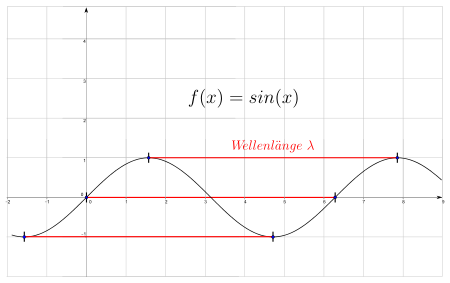Wavelength
The wavelength λ  (Greek: lambda) of a periodic wave is the smallest distance between two points of the same phase. Two points have the same phase if they have the same displacement (elongation) and the same direction of motion in time. The wavelength is the spatial analogue of the periodic time.
(Greek: lambda) of a periodic wave is the smallest distance between two points of the same phase. Two points have the same phase if they have the same displacement (elongation) and the same direction of motion in time. The wavelength is the spatial analogue of the periodic time.
In general

where  the phase velocity and
the phase velocity and  is the frequency of the wave.
is the frequency of the wave.
However, for a given frequency, phase velocity and wavelength depend on the propagation medium and the geometry of the wave. If necessary, one speaks of vacuum wavelength or free-space wavelength to differentiate, if one does not mean the wave in the medium or the wave in a waveguide.


The wavelength, graphically illustrated, is the distance between two adjacent crests or, more generally, between two adjacent points of the same phase (that is, points with the same deflection and the same slope).
Wavelength of sound waves
The human ear is sensitive to frequencies of at most about 16 hertz to 20 kHz (corresponding to a wavelength range of about 21 m to 17 mm at a sound propagation velocity in the medium air of  = 343 m/s), although the ability to perceive higher frequencies generally decreases with age. Since the wavelength is proportional to the speed of sound propagation in the medium of propagation, a sound with a frequency of 16 hertz in water (
= 343 m/s), although the ability to perceive higher frequencies generally decreases with age. Since the wavelength is proportional to the speed of sound propagation in the medium of propagation, a sound with a frequency of 16 hertz in water (  = 1484 m/s) has a wavelength of approximately 90 m. The auditory impression, the pitch, is given by the frequency, not by the wavelength in a medium outside the ear, because the sound propagation velocities of the media in the inner ear-and thus the wavelengths of a given sound occurring there-are independent of the media through which the sound reaches the eardrum. Certain animal species can also perceive sound waves with lower or higher frequencies, hence sound of other wavelength ranges.
= 1484 m/s) has a wavelength of approximately 90 m. The auditory impression, the pitch, is given by the frequency, not by the wavelength in a medium outside the ear, because the sound propagation velocities of the media in the inner ear-and thus the wavelengths of a given sound occurring there-are independent of the media through which the sound reaches the eardrum. Certain animal species can also perceive sound waves with lower or higher frequencies, hence sound of other wavelength ranges.
Wavelength of electromagnetic radiation
→ Main article: Electromagnetic spectrum
Wavelengths of visible light: Colors
The human eye is sensitive in a wavelength range from about 380 nm (violet) to 780 nm (red). Bees also see shorter wavelength radiation (ultraviolet), but cannot perceive red light for it. Under optimal conditions, the limits of human perception can be 310 nm (UV) to 1100 nm (NIR).
Wavelength of electromagnetic waves in the medium
For the wavelength in a medium holds:

Where  is the speed of light in vacuum, μ
is the speed of light in vacuum, μ  is the magnetic permeability and ε
is the magnetic permeability and ε  is the relative permittivity of the medium. When electromagnetic waves pass through a medium whose refractive index
is the relative permittivity of the medium. When electromagnetic waves pass through a medium whose refractive index  greater than
greater than  , this reduces the wavelength and the speed of propagation. The frequency of the wave remains the same. The wavelength in the medium is
, this reduces the wavelength and the speed of propagation. The frequency of the wave remains the same. The wavelength in the medium is

where λ  is the wavelength of the electromagnetic wave in vacuum.
is the wavelength of the electromagnetic wave in vacuum.


Overview of electromagnetic waves with the visible spectrum in detail
Search within the encyclopedia















